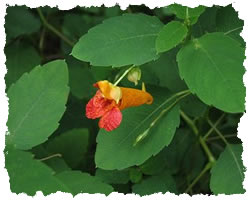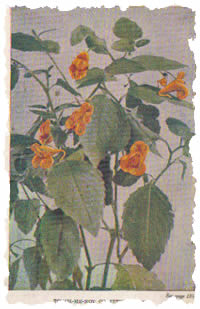Jewel Weed Impatiens capensis

Jewelweed
- Common Names
- Jewel Weed , Jewelweed, Wild Balsam. Balsam-weed. Impatiens, Spotted Touch-me-not, Lady's Eardrops, Lady's Slipper
- Botanical Name
- Impatiens capensis
- Family
- Balsaminaceae
Medicinal Uses & Benefits of Jewel Weed
![]() How to Use|
Side Effects |
Plant & Garden|
How to Use|
Side Effects |
Plant & Garden|
- Medicinal Uses: * Eczema
* Insect/flea Bites
* Rashes
* Spring Tonics
- Properties: * Insect repellents * Skin tonic
- Parts Used: Fresh juice
- Constituents: tannin, lawsone
How to Use: Jewel Weed
The juice of jewelweed is a traditional remedy for all sorts of skin ailments including poison ivy. An oft-repeated folk saying, "Wherever poison ivy is found, jewelweed grows close by". To use it, you can simply crush the leaves and rub it on the itchy places. Jewelweed has enjoyed a popular place in home remedies for centuries. Its medical qualities have not shown much promise in scientific studies, but that doesn't mean much to those who use it and swear by its effectiveness.
Preparation Methods & Dosage :Raw juice and leaves are used in topical skin treatments to counteract rashes and skin irritation, most notably those caused by poison ivy.
Jewel Weed Remedies
 In the Kitchen: The edibility of jewelweed is a subject of debate with many sources considering the plant toxic. However, the young fresh shoots gathered before the plant flowers are edible according to the indomitable Euell Gibbons1, who cooked them "like green beans". Jewelweed is also eaten as a spring green in West Virginia, where it grows wild.2"
In the Kitchen: The edibility of jewelweed is a subject of debate with many sources considering the plant toxic. However, the young fresh shoots gathered before the plant flowers are edible according to the indomitable Euell Gibbons1, who cooked them "like green beans". Jewelweed is also eaten as a spring green in West Virginia, where it grows wild.2"
Jewel Weed Side Effects: The juice of the fresh mature leaves is for external use only.
Plant Description

Spotted Touch-Me-Not
- Flowers:Orange yellow, spotted with reddish brown, irregular, 1 in. long or less, horizontal, 2 to 4 pendent by slender footstalks on a long peduncle from leaf axils. Sepals, 3, colored; 1 large, sac-shaped, contracted into a slender incurved spur and 2-toothed at apex; 2 other sepals small. Petals, 3; 2 of them 2-cleft into dissimilar lobes; 5 short stamens, 1 pistil.
- Stem: 2 to 5 ft. high, smooth, branched, colored, succulent.
- Fruit: An oblong capsule, its 5 valves opening elastically to expel the seeds.
- Leaves: Alternate, thin, pale beneath, ovate coarsely toothed, petioled.
- Preferred Habitat:Beside streams, ponds, ditches; moist ground.
- Flowering Season: July - October.
- Distribution: Nova Scotia to Oregon, south to Missouri and Florida
These exquisite, bright flowers, hanging at a horizontal, like jewels from a lady's ear, may be responsible for the plant's folk-name; but whoever is abroad early on a dewy morning, or after a shower, and finds notched edges of the drooping leaves hung with scintillating gems, dancing, sparkling in the sunshine, sees still another reason for naming this the Jewel-weed. In a brook, pond, spring, or wayside trough, which can never be far from its haunts, dip a spray of the plant to transform the leaves into glistening silver. They shed water much as the nasturtiums do.
Familiar as we may be with the nervous little seed-pods of the touch-me-not,which children ever love to pop and see the seeds fly, as they do from balsam pods in grandmother's garden, they still startle with the suddenness of their volley. Touch the delicate hair-trigger at the end of a capsule, and the lightning response of the flying seeds makes one jump.
Netje Blanchan Wild Flowers worth Knowing(1917)Regional Traditions :North America *
History and Traditions & Folklore
Under the name of Jewelweed the herbage of Impatiens aurea and of I. biflora are largely employed in domestic practice and by homeopaths and eclectics. The herbs have an acrid, burning taste and act strongly as emetics, cathartics and diuretics, but are considered dangerous, their use having been termed 'wholly questionable.3- Euell Gibbons. "Stalking the Healthful Herbs", Alan Hood (1966), pg 207
- A reader, Janet from West Virginia, was kind enough to share her recipe for this spring green. "Mix the jewelweed with nettleweed then boiled until tender in a small amount of water. Drain, then fry in oil or butter. Add salt and pepper to taste. Jewelweed turns greener when you cook it. Really pretty. Jewelweed taste something like spinach by itself.
- Grieve, Maud Mrs. "A Modern Herbal" (1931)










